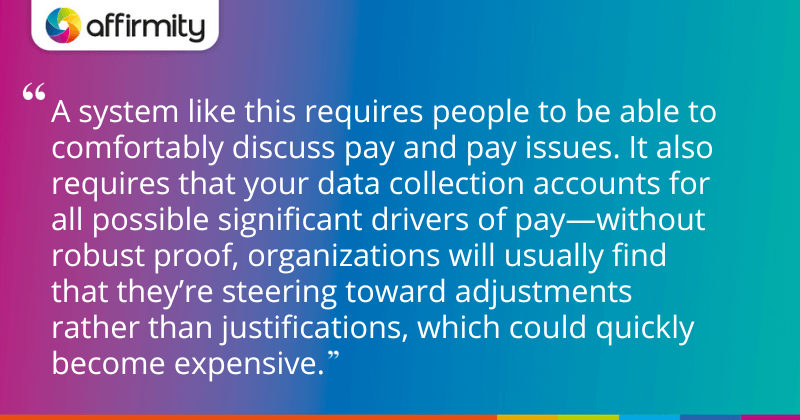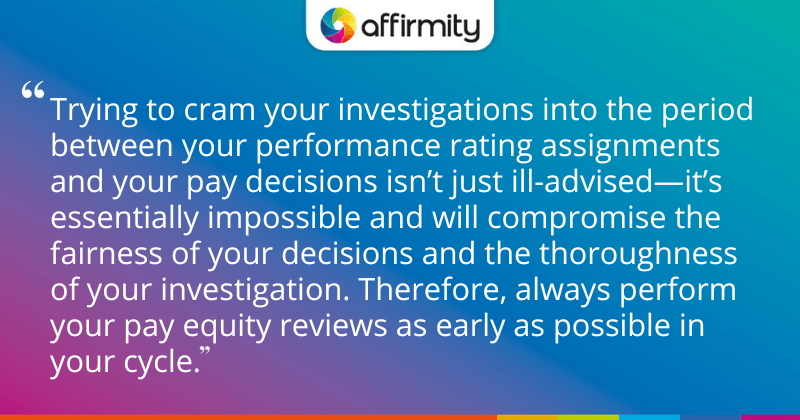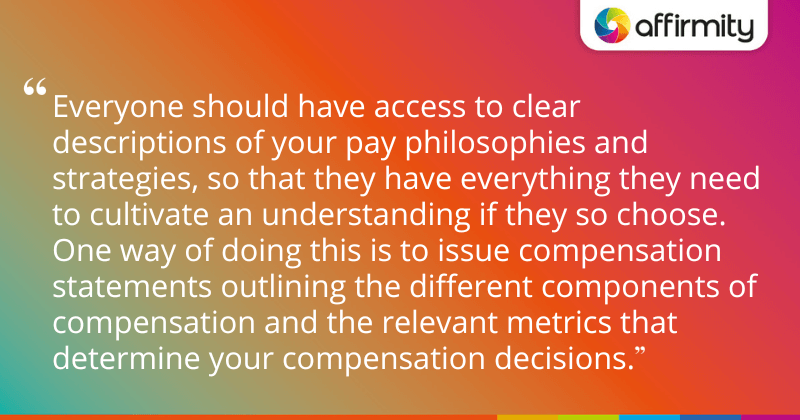Between the increase in federal, state, and local-level lawmaking on pay transparency and reporting, and the growing public scrutiny of pay gaps, a wholesale embrace of pay equity has become a necessity rather than just a wise business decision for most organizations. However, pay equity is a process that must be approached with precision, and a cultural and philosophical shift that requires significant groundwork. In this article, Affirmity principal business consultant Patrick McNiel, PhD, sets out a five-point plan for creating the foundations of your cultural transformation.
1) Conduct Your Pay Equity Analyses
At the core of your pay equity response is a robust analysis of your current situation. This knowledge will be the springboard to a wider cultural change, and there’s a lot of additional work involved in getting its findings understood and acted upon—however, without any grounding in what your pay equity analysis issues are, and where they originate from, you’ll be going nowhere fast.

This understanding comes via a pay equity analysis, and this effort requires a lot of data to be gathered for each employee. The list of relevant data points will vary based on your industry and context, but broadly you may consider points such as:
- Race
- Gender
- Location
- Role
- Typical performance level
- Time with company
- Time within role
- Experience level at time of hiring
- Education level
In your analyses, these data fields may be relevant to investigations of many forms of compensation. Base pay is typically of primary concern, but bonuses, equity, and any other compensation items contributing toward total pay should be investigated as well. For each group you investigate, you have a range of statistical and methodological options to choose from. You’ll want to pick one that is appropriate for the properties of the group.
For example, in larger groups you could run a multiple regression analysis to see which factors correlate or do not correlate with compensation after controlling for the other factors. This can give you a good idea of the effects gender and race have on pay levels after considering the other factors. But, for very small groups it may be more appropriate to do a simple cohort analysis, where you order pay from lowest to highest and see with your eyeballs if this ordering fits with the characteristics employees have. It may be beneficial to consult with someone well-versed in statistical methodology and pay equity issues when conducting pay equity analyses.
Whatever method you utilize, if you find that class groups (such as gender or race classes) relate to pay even after accounting for other important pay drivers, you may have a pay equity issue. At this point, you’ll want to perform additional analyses and investigations to drill down to root causes. This will vastly improve your ability to recommend effective remedial action.
MORE ON PAY EQUITY PROCESS | ‘Getting Pay Equity Analysis Off the Ground: The First 3 Steps of Your Process’
2) Iterate and Improve Your Process While Opening Up the Discussion
You need a degree of openness to fully embed a culture of pay equity. This requires a deconstruction of social norms that, especially for Baby Boomers and Gen Xers, make discussing pay taboo.
A company should ideally be able to explain to employees why they make what they make, and what they make should be tied to a rational and uniformly applied criteria for each job. Doing so creates fairness in process and in information, and it gives employees the knowledge needed to ask about perceived pay discrepancies without going straight to an agency or third party. If the organization is fair in its dealings, it will be able to investigate whether a discrepancy exists, and thereafter provide a reasonable justification for that discrepancy or provide an adjustment if appropriate.
However, a system like this requires people to be able to comfortably discuss pay and pay issues. It also requires that your data collection accounts for all possible significant drivers of pay—without robust proof, organizations will usually find that they’re steering toward adjustments rather than justifications, which could quickly become expensive.
For example, one of the single most important drivers of pay that regularly seems to escape documentation is the job-relevant experience that a new employee brings with them at the time of hiring. This experience has a large and relevant effect on starting pay—if it isn’t captured as a factor, future pay equity adjustments will not be able to account for it, and this can result in pay that’s actually less fair for employees who were more experienced at hire. An inequitable adjustment is both costly and likely to cause other pay fairness issues to crop up.
So as you iterate and improve on your process, you’ll need to make sure that you identify key variables like this and have the data necessary for a pay equity analysis. To this end, it’s important to ask for feedback about the pay-setting process, adjustment mechanisms, and pay investigations from people who understand those issues on the ground. Namely, your HR professionals, hiring managers, compensation decision-makers, and other key stakeholders.

3) Avoid These Common Mistakes
As we set further off down the path of designing a pay equity-ready culture, it’s worth pausing to consider some common mistakes that are easily made and worth avoiding.
i) Aggregating Management Discretionary Spend Without Oversight
Your managers need a common formula to follow when assigning the vast majority of pay increases. This doesn’t mean that they should be prohibited from ever making decisions outside the framework if there’s a justification for them—however, deviations from the formula should be documented and discussed with HR so the reasoning can be validated and reported. Without this oversight, discretionary spend can get out of control, and the organization may find itself paying out to correct unforced inequities created by rogue managers.
ii) Looking for Quick Fixes Without a Long-Term Strategy
In equity terms, the quickest fix is to simply throw money at the problem. Inequity is embarrassing, and correcting it in this way may be well-intentioned. However, failing to also create a long-term strategy with controls, guidelines, expectations, and a program of gradual adjustments will often exacerbate the problem. Throwing money at pay equity issues without investigating and addressing the root causes tends to result in temporary fixes at best. At worst, you simply shift the inequity elsewhere, creating new and potentially more complex problems requiring intervention.
iii) Reviewing Pay Equity Only After Talent Process Completion
Every stage of a pay equity investigation is potentially time-consuming: not only the initial investigation into where there may be areas of inequity, but also any subsequent studies into the causes of specific discrepancies, and the formulation of strategies to combat whatever is found. Trying to cram your investigations into the period between your performance rating assignments and your pay decisions isn’t just ill-advised—it’s essentially impossible and will compromise the fairness of your decisions and the thoroughness of your investigation. Therefore, always perform your pay equity reviews as early as possible in your cycle.
iv) Failing to Review and Audit Processes Continuously
The need to get on top of your pay equity reviews early hints toward the proactive approach that will serve you well in general. You’ll want to be reviewing and auditing your processes on a continual basis because companies, roles, employees, and decision-makers change. Pay equity, its causes, and the utility of its processes are all in constant flux—they all need to be looked at continuously (at least yearly) to account for the changes that occur.
LEARN ABOUT PAY EQUITY ANALYSIS SOFTWARE | ‘6 Pay Equity Analysis Software Features That Simplify Your Process’
4) Educate Your Decision Makers…
Communication is key to most cultural changes, so you’ll need to make sure your leaders at all levels have access to and understand your pay philosophy and pay equity strategy. You should communicate this to them year-round, not just once a year prior to the start of your compensation planning cycle. Use various formats, such as videos, training materials, presentations during all-hands meetings, and every other avenue available to you (within reason).
If you have annual unconscious bias training, make sure the message is consistent with your values, but also ensure that it’s communicated in forms beyond those that go out to just your compensation planning and performance managers (though clearly they have a pivotal role to play). HR needs to be able to spot unconscious bias too, for example.
Your training should enable your decision-makers to spot and mitigate a range of common unconscious biases when making important decisions that affect pay. This includes not just gender and ethnic biases, but also:
- Recency bias: a bias displayed when managers evaluate performance on the basis of the last few weeks or months of performance without considering the complete evaluation period
- Central tendency or lack of differentiation bias: managers displaying this bias skew all performance ratings to the center of the available scale, perhaps to avoid difficult conversations around justifying ratings at either extreme
- Halo effect: managers may be prone to letting an employee’s performance in one area influence their perception of all other areas. For example, an employee may be perceived as always enthusiastic and willing to help, and may receive a raise on this basis despite actually only performing as well as another employee who is paid less.
In this way, cultural change isn’t just about communicating expectations to your stakeholders, it’s about equipping them with both tools to communicate their reasoning for their decisions and a better facility for making objective decisions. Training should therefore include tips and pointers on having conversations about pay, and how they can bring HR into these conversations as well.

5) …And Educate All Your Employees
Communication for cultural change can only go so far if you limit your audience. It’s better to reach all your employees. Everyone should have access to clear descriptions of your pay philosophies and strategies, so that they have everything they need to cultivate an understanding if they so choose. One way of doing this is to issue compensation statements outlining the different components of compensation and the relevant metrics that determine your compensation decisions.
Remember that proper communication is a two-way street, so it’s essential to be prepared for employees to feel comfortable discussing compensation-related questions with their managers or with HR.
TRANSFERABLE IDEAS FOR TALKING ABOUT DATA | ‘Getting the Business On Your Side: How to Talk About Affirmative Action Data With Everyone Else’
In Conclusion
When pay is fairly implemented and employees have a clear understanding of the reasons behind their pay, the components that make up their pay, and the process you have in place to address pay issues, you can realistically expect greater satisfaction and retention. Failure to implement a culture of pay equity, and accompanying systems and processes, is becoming a greater and greater risk. This risk now extends from the legal landscape to issues of reputation, employee engagement, and competitive advantage.
 About the Author
About the Author
Patrick McNiel, PhD, is a principal business consultant for Affirmity. Dr. McNiel advises clients on issues related to workforce measurement and statistical analysis, diversity and inclusion, OFCCP and EEOC compliance, and pay equity. Dr. McNiel has over ten years of experience as a generalist in the field of Industrial and Organizational Psychology and has focused on employee selection and assessment for most of his career. He received his PhD in I-O Psychology from the Georgia Institute of Technology. Connect with him on LinkedIn.
